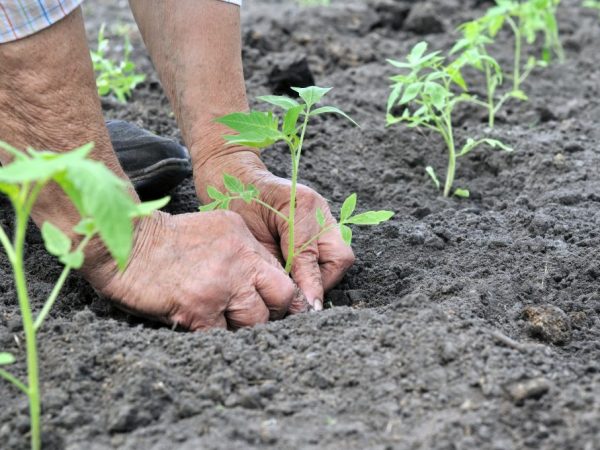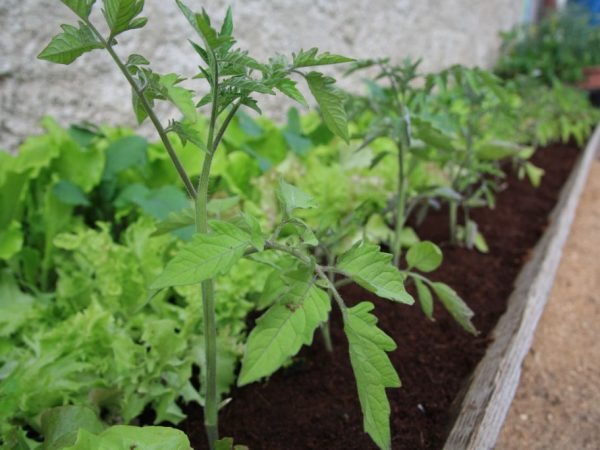Temperature for planting tomatoes
To get a bountiful harvest, you need to know the peculiarities of growing plants. Tomatoes are a capricious and thermophilic culture, so they often die due to the mistakes of farmers. What is the correct planting temperature for tomatoes? Let us examine in detail the factors under which a positive result can be achieved.

Planting temperature for tomatoes
Optimal temperature conditions
When growing vegetables in a domestic climate, often all plantings are frozen at the first cold snap. Ignorance of the requirements of culture becomes fatal. Even cold-tolerant hybrids in the early stages are unable to withstand temperature errors.
Tomatoes of all varieties react sharply to both low and high thermometer readings. The critical values are 5 ° C for the dark time of the day and 42 ° C for the day. In these cases, it is difficult to reanimate the planting, so experienced farmers try to avoid mistakes. Already at a temperature of 16 ° C:
- the development of the root system stops;
- the number of ovaries on the stems decreases;
- poorly absorbed water and nutrients;
- diseases are activated;
- there is rotting of underground parts.
In the heat, plants shed their foliage and flowers, which also negatively affects the future harvest. Growing a crop in a greenhouse or covering it with a dark film provokes overheating, which is also dangerous for capricious tomatoes. The humid warm air is an excellent environment for the development of diseases.
Planting stages
To grow a healthy plant in domestic conditions, it is necessary to know the temperature characteristics for each period of development. Failure to comply with the regime will instantly affect the general state of the culture. Seed producers often indicate requirements on packaging.
Seedling
To get healthy young growth of tomatoes, it is necessary to plant the planting material correctly. Before sowing, the seeds are first warmed up in warm water: 5-10 minutes at a temperature of 50 ° C to 60 ° C. After the procedure, they are laid out on a napkin to absorb moisture, then placed in the refrigerator for a couple of days. Such manipulations activate the protective properties of the culture, preparing for climatic fluctuations.
After sowing, the containers are covered with glass or polyethylene, creating a mini-greenhouse inside. Recommended temperature for germination is from 24 ° С to 27 ° С, without sudden fluctuations. Seedlings cannot be kept in such conditions for a long time, otherwise the seed material will die. With the appearance of the first shoots, the shelter is removed, and the containers are transferred to a bright place, after which they keep the heat at 20 ° C during the day, and from 16 ° C to 18 ° C at night.

Temperature drops are harmful to seedlings
To prevent the seedlings from stretching, it is advised to reduce the temperature during the day to 15 ° C, and in the dark - to 10 ° C. A cold snap will halt the development of the stems, especially in low light conditions.
Hardening
Before planting tomatoes in open ground or a greenhouse, it is necessary to gradually accustom the plants to environmental conditions. The hardened seedlings quickly adapt to the new growth site, so they will not hurt. If you ignore this requirement, tomatoes are delayed in development and die from the very first weather fluctuations.
After picking, you can start hardening the culture. For this, containers are taken out onto the balcony or outside, leaving the young at a temperature of at least 15 ° C. Gradually increase the time spent outdoors and reduce the degree. In the last couple of days before planting, it is recommended to leave the plants overnight at 10 ° C.
If you start hardening from mid-April, the seedlings will be undersized. A purple hue on the leaves is a good sign.
Tomatoes should not stand on a cold surface: the roots react violently to any changes. Seedlings are recommended to be kept on a windowsill or on a table. To cool the room, open a window or balcony sash.
Landing in open ground
After the seedlings have passed hardening, proceed to the next stage. At what temperature can tomatoes be planted in the ground? Night frosts will reduce all efforts to zero, so it is necessary to carry out control measurements of the soil for several days.
It is recommended to start planting after the open ground has warmed up to 12 ° C. Experienced farmers place thermometers in different parts of the garden. Work can be started as soon as the device shows the required data. In order for the seedlings to take root, it is better to plant them in the evening or in cloudy weather. The sun will not burn the foliage, so the procedure will be stress-free.
What to do if you urgently need to start planting work, but the soil has not warmed up? An hour before the event, 1 liter of hot water is poured into each hole, after which the surface is hidden under a film. Covering material with which the seedlings are blocked before the onset of stable heat will save from frost.
Planting in a greenhouse
At what temperature should tomatoes be planted in greenhouses? The rays of the sun penetrate perfectly into the construction of polycarbonate, polyethylene or glass, while maintaining heat. A microclimate with constant humidity is created inside the greenhouse, which stimulates the seedlings to active development.

The compost layer will keep you warm
They start planting tomatoes only when the soil in the greenhouse warms up to 14 ° C above zero. An ordinary outdoor thermometer is used for measurements. The device is placed in a hole to a depth of at least 12 cm. The day before work, the lower foliage is removed from the seedlings.
Tall beds are recommended to be cultivated or naturally heated with compost and humus. When growing early varieties, it is necessary to ensure that the indicators in the structure do not fall below 13 ° C. In such conditions, pollen does not ripen, which negatively affects the harvest.
Disembarkation dates
There are no specific dates for agricultural work. Each farmer determines his own schedule, corresponding to the climatic conditions. To protect seedlings in the Middle Lane, 3 stages of planting in open ground are carried out:
- in the end of April;
- from 3 to 10 May;
- at the end of May.
In regions with cooler climates, it is customary to grow tomatoes in a greenhouse, so work takes place during the May holidays. When growing early hybrids, planting in unprotected soil begins from 6 to 10 June. Having approximate dates, it is necessary to carefully measure the temperature in different parts of the garden.
How to protect against frost
Even the most complex calculations cannot predict the whims of nature. If night frosts are predicted, it is necessary to know how to protect plants.
- Special covering materials. Polyethylene, agrofibre can briefly protect the seedlings from frost.
- Plastic containers. For small areas, it is enough to simply close the seedlings with buckets.
- Bonfire.To protect tomatoes from the cold at night on a large plantation, you need to heat the plants with smoke. Around the beds from the windward side, fires are kindled from scrap materials (old foliage, branches, paper).
- Sawdust. Due to the humidity in the greenhouse, the seedlings die when the temperature drops to -1 ° C, so it is better to cover the bushes with the remains of woodworking.
Recommendations
In poor light and low temperatures, the plant stops developing. The roots stop assimilating water and feeding, which contributes to the activation of ailments. In cloudy weather, tomatoes are advised not to water until the soil is completely dry.
With a sharp temperature drop, unadapted bushes die. If the forecast promises frosts in the next week, it is better not to risk it and postpone agricultural work to a more favorable period.
Tomatoes are a favorite vegetable crop of domestic farmers. Knowing what temperature to plant tomatoes at can help you avoid many common problems.


